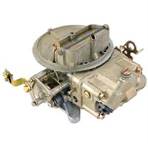Some Background on Carburetors

It’s impossible to write one article that covers how to on carburetor rebuilds. The automobile history has never- ending approaches to design of carburetors. This article will focus on one of the most common…the Holley two-venturi, or more commonly known as the two-barrel.
Even though there were the Carter and the Rochester, the Holley was fitted to an unbelievable number of 50’s and ‘60 cars. Since most collectors are interested in those two decades, probably because most collectors are middle-aged and these are the cars they drove. Another reason is that most cars of that vintage had V-8’s fitted with two-barrel carburetors. Many were made by or under license to Holley.
The Disassembly Process
Two barrels are relatively simple and contain all five basic systems. Before working on one, you must be familiar with how it works, so take the time to get a solid understanding of the technology. Start with a notepad and ask these questions:
Did it easily start when cold?
Does it run rich (smell of gas)?
Did it hesitate when accelerating?
Does it have any flat spots when cruising?
Did it have any leaks?
It’s important to know these facts so when the carburetor is disassembled you can look for problem areas. Before starting any carburetor rebuilds, first, open your kit box to make sure again it’s the right one for your carburetor. Lay all parts out on a clean worktable or bench. Cover with craft paper or brown wrapping paper…something that will contrast with your parts and it will also help keep the area clean.
Disassemble the carburetor systematically and place it in order of removal. Clean the exterior of the carburetor after disassembly rather than before, because it’s possible to push dirt inside. Next, follow the instruction sheet and start taking the external parts off the carburetor.
Soak all parts (except those made of rubber, leather, fabric, electrical components, diaphragms, plastic) in clean carburetor cleaner. Carburetor cleaner can be found in tubs and spray cans and is typically tri-clorethylene based. It’s toxic to breathe, to make sure the area is well ventilated. An alternative to using carburetor cleaner is to use strong detergent (liquid dishwasher detergent works well) and hot water. Parts will have to soak for a while, but will come out clean. An advantage is that the other parts that are damaged in solvent can be cleaned this way. Clean parts one-at-a-time if you aren’t familiar with order of assembly, or use a container that is large enough to keep everything in order.
When all parts are clean and dry, start the assembly process. This process should be relatively easy if all parts were laid out as removed.